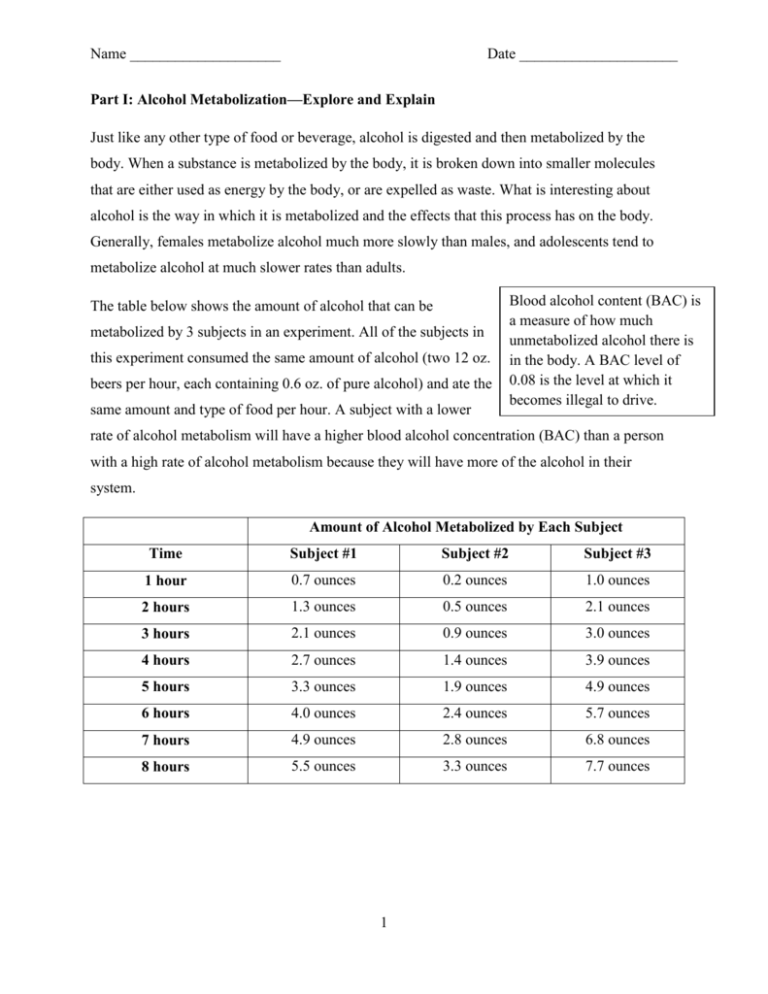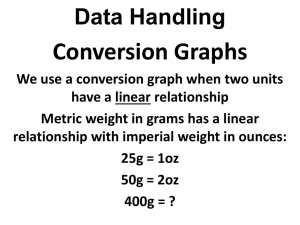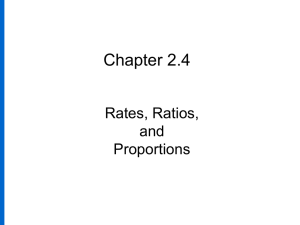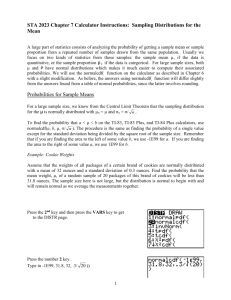Word Version of Answer Key
advertisement

Name ____________________ Date _____________________ Part I: Alcohol Metabolization—Explore and Explain Just like any other type of food or beverage, alcohol is digested and then metabolized by the body. When a substance is metabolized by the body, it is broken down into smaller molecules that are either used as energy by the body, or are expelled as waste. What is interesting about alcohol is the way in which it is metabolized and the effects that this process has on the body. Generally, females metabolize alcohol much more slowly than males, and adolescents tend to metabolize alcohol at much slower rates than adults. The table below shows the amount of alcohol that can be metabolized by 3 subjects in an experiment. All of the subjects in this experiment consumed the same amount of alcohol (two 12 oz. beers per hour, each containing 0.6 oz. of pure alcohol) and ate the same amount and type of food per hour. A subject with a lower Blood alcohol content (BAC) is a measure of how much unmetabolized alcohol there is in the body. A BAC level of 0.08 is the level at which it becomes illegal to drive. rate of alcohol metabolism will have a higher blood alcohol concentration (BAC) than a person with a high rate of alcohol metabolism because they will have more of the alcohol in their system. Amount of Alcohol Metabolized by Each Subject Time Subject #1 Subject #2 Subject #3 1 hour 0.7 ounces 0.2 ounces 1.0 ounces 2 hours 1.3 ounces 0.5 ounces 2.1 ounces 3 hours 2.1 ounces 0.9 ounces 3.0 ounces 4 hours 2.7 ounces 1.4 ounces 3.9 ounces 5 hours 3.3 ounces 1.9 ounces 4.9 ounces 6 hours 4.0 ounces 2.4 ounces 5.7 ounces 7 hours 4.9 ounces 2.8 ounces 6.8 ounces 8 hours 5.5 ounces 3.3 ounces 7.7 ounces 1 1. Graph the rate of metabolism for each person in the graphs provided below. Make sure to include all parts of a graph (title, axes titles, etc.), as well as a trend line for each graph. Amount of Alcohol Metabolized Metabolization of Subject 1 6 y = 0.6893x - 0.0393 R² = 0.9978 5 4 3 Series1 2 Linear (Series1) 1 0 0 2 4 6 8 10 Time (hours) Amount of Alcohol Metabolized Metabolization of Subject 2 3.5 y = 0.4548x - 0.3714 R² = 0.9967 3 2.5 2 Series1 1.5 Linear (Series1) 1 0.5 0 0 2 4 6 8 Time (hours) 2 10 Amount of Alcohol Metabolized Metabolization of Subject 3 9 y = 0.9464x + 0.1286 R² = 0.9993 8 7 6 5 4 Series1 3 Linear (Series1) 2 1 0 0 2 4 6 8 10 Time (hours) 2. Calculate the average rate of alcohol metabolism for each subject. (Show your work!) a. Subject 1: 0.689 oz/hour b. Subject 2: 0.454 oz/hour c. Subject 3: 0.946 oz/hour d. How did you calculate the average rate of metabolism? Explain why you chose this process. There may be a variety of different ways that a student answers these questions. They may get this answer from the slope of the linear regression, which is the most accurate way to calculate the rate of metabolism. OR, they may also take two of the points on the graph and try and calculate slope that way. It is up to you to determine which answer you consider “correct.” e. The researcher who gathered this data calculated the average rate of metabolism two different ways. First the scientist calculated the slope of the linear regression. Then the scientist took the difference between each hour 8 and hour 1 and then divided it by 8 (for 8 hours). Which method do you think is more accurate and why? It is more accurate to calculate the rate of metabolism from the slope because it takes into account all of the points on the graph and it also accounts for any outliers in the data. 3 3. Hypothesize the age and gender of subjects 2 and 3. Explain your reasoning. a. Subject 2: young female, maybe adolescent age (16-20) based on the low rate of metabolism. Females metabolize alcohol much more slowly than males as do people who have not been previously exposed to alcohol, so it is assumed that this person has not really been exposed to alcohol. Answers may vary for this section. b. Subject 3: older male, maybe 30s or 40s based on the high rate of metabolism. Males metabolize alcohol much more quickly than females and it is assumed this person is older because he can metabolize alcohol quickly so he most likely has been exposed to alcohol for quite some time and a has a tolerance built up. Answers may vary for this section. This question is here in order to allow students to begin thinking about how alcohol may affect his/her body. Part II: Experiment A researcher wanted to know if there was a difference in the way that the consumption of alcohol affected adults and adolescents. This researcher designed an experiment that tested the alcohol metabolism of 8 different people as an adolescent—age 18—and as an adult—age 30. The experimental setup was the same when the participants were an adolescent and when they were an adult. Each participant drank two 12 oz. beers every hour for 8 hours and ate the same type and amount of food throughout the experiment. The average metabolism of each person per hour is listed in the table below. Before becoming a subject in this experiment, each participant was screened to see if they had the correct qualifications to be a part of this experiment. Therefore, each subject has a family history of alcoholism in their immediate family going back at least 3 generations (for example, Alcoholism is an addiction to the consumption of alcoholic beverages in which a person is physically dependent on the alcohol. If an alcoholic stops consuming alcohol he/she will likely have withdrawal effects because the body is so used to having alcohol in the system. father, father’s mother, and father’s grandfather). Also, none of the subjects showed signs of alcoholism nor did they become alcoholics before the experiment was concluded. The table below shows the average body weight and metabolic rate of each subject as an adolescent and as an adult. 4 Body Weight Adolescent Body weight as Adult as Adolescent Metabolic Rate Adult Metabolic Rate 1 40 kg 0.257 oz/hr 55 kg 0.689 oz/hr 2 48 kg 0.598 oz/hr 59 kg 1.143 oz/hr 3 52 kg 0.454 oz/hr 53 kg 1.022 oz/hr 4 70 kg 0.491 oz/hr 72 kg 0.984 oz/hr 5 61 kg 0.643 oz/hr 67 kg 1.123 oz/hr 6 50 kg 0.342 oz/hr 56 kg 0.887 oz/hr 7 56 kg 0.232 oz/hr 60 kg 0.769 oz/hr 8 75 kg 0.334 oz/hr 75 kg 0.735 oz/hr Subject # Note: 100 pounds is equivalent to 45 kg, and 200 pounds is equivalent to 91 kg. Answer questions 1-5 based on the table above. 1. Why is it important that each person had a family history of alcohol use, but did not develop alcoholism? It is assumed that if a person has a family history of alcoholism, he/she will be able to break down more alcohol, and we want this factor to be equal across all participants. 2. Each of the participants drank 24 oz. of alcohol over the course of 8 hours. Calculate the grams of alcohol that each participant drank over 8 hours. (Hint: 1 oz. = 28.35 g) 24oz. x 28.35 g/oz.= 680.4 g Grams Alcohol Consumed: 680.4 g 5 3. Based on the body weight of each subject (as an adult and adolescent), calculate the grams of alcohol consumed/kilogram of body weight for each subject at both age points. Display your data in the table provided below. Subject # Adolescent (g/kg) Adult (g/kg) 1 17.01 12.37 2 14.18 11.53 3 13.08 12.84 4 9.72 9.45 5 11.15 10.16 6 13.61 12.15 7 12.15 11.34 8 9.07 9.07 a. What is the purpose of calculating the g alcohol consumed/kg body weight for each individual if you already know how many ounces of alcohol they consumed? Because it takes more alcohol for a person with more body mass to feel the effects of alcohol. Therefore, in order to be able to compare the amount of alcohol drank across all subjects, it is necessary to convert to g/kg 4. Hypothesize whether or not you think that the metabolic rates of the adults are significantly higher than the metabolic rates of the adolescents. Answers will vary for this section. 5. Perform a t-test to determine if the metabolic rates of the adults are significantly higher than the metabolic rates of the adolescents. Set α = 0.05 Null Hypothesis H˳ = no statistical difference Specified mean of differences μ˳ = 0 H1 = Adult metabolic rate is higher Actual Mean of Difference μD = 0.500 Standard deviation of differences: 0.0597 6 Number of Samples: 8 How to Calculate Actual Mean of Difference μD 0.689 – 0.257 = 0.432 Differences added up = 4.001 1.143 – 0.598 = 0.545 1.022 – 0.454 = 0.568 0.984 – 0.491 = 0.493 4.001/8 = 0.500 1.123 – 0.643 = 0.480 0.887 – 0.342 = 0.545 0.769 – 0.232 = 0.537 0.735 – 0.334 = 0.401 How to calculate Standard Deviation of the Differences 1 ( D x) 2 n 1 1 (0.5 0.432) 2 (0.5 0.545) 2 (0.5 0.568) 2 ..........(0.5 - 0.401) 2 8 1 0.0597 How to calculate the t-value t D standard deviation of difference n 0.5 0 t 23.7 0.0597 8 How to calculate the p-value Look at the p-value chart that was provided on the website with this lesson plan t-value: 23.7 p-value<0.001 7 a. Are the results significant? Explain. Make sure to include the size of the sample and the family histories of the individuals to further expand on your answer. Yes the results are significant. There is greater than a 99.999% chance that these results are not due to chance (less than 0.001% that they are due to chance). The sample size, however, was relatively small, so it is always a good idea to do further testing in order to prove your hypothesis. All of these individuals had a family history of alcohol use, which could have caused them to have a genetic influence that allowed them to metabolize alcohol more quickly. Further testing should be done to compare people with family history of alcoholism and those without a family history of alcoholism. b. You may notice that the t-value that you get for this test is not even on the chart of t-values. Explain what this means in terms of how significant your results are. It means that the results are extremely significant, and that you, as a scientist, can be sure that the results are this specific experiment are not due to chance. c. Explain why a t-test was more appropriate to use than a chi-square test. This data was paired—meaning that the metabolic rate of the adult was dependent on the metabolic rate of the adolescent. In order to compare data that is paired, it is necessary to look at the differences between the data in order to compare them. With a chi-square test, you must have a set of data that you expect to gather from your experiment. So in this case, a paired t-test was more appropriate to use. 8 You may be interested to know that after each hour of alcohol consumption, each subject was asked to complete a series of physical and mental tests. The physical tests included walking in a straight line, jumping on one foot without falling down, and balancing on one foot. The mental tests included recognizing patterns, performing mental math, and reading simple sentences. The data from hour 0 (before the experiment began), hour 2, and hour 8 are shown in the tables below. A score of 100 means that the subject completed all tests with no errors, and a score of 0 means that the subject failed every question and every test given. Hour 0 Subject # Score as an Adolescent Score as an Adult 1 84 84 2 95 93 3 90 90 4 91 90 5 97 98 6 84 87 7 85 84 8 89 88 Subject # Score as an Adolescent Score as an Adult 1 83 84 2 92 90 3 90 90 4 91 90 5 99 98 6 86 87 7 85 86 8 89 88 Hour 2 9 Hour 8 Subject # Score as an Adolescent Score as an Adult 1 76 42 2 86 56 3 86 41 4 83 60 5 92 39 6 80 54 7 81 56 8 84 49 6. Perform a t-test for each of the hours (0, 2, and 8) to determine whether or not the adolescents have higher scores than the adults. Set your α=0.05. This data was calculated in the same way as in question #5 above. a. Hour 0 H˳ = no statistical difference H1 = the adolescents have higher scores μ˳ = 0 t = 0.227 μD = 0.125 p > 0.5 How to Calculate Actual Mean of Difference μD 84 - 84 = 0 85 – 84 = 1 95 – 93 = 2 89 – 88 = 1 90 – 90 = 0 91 – 90 = 1 Differences added up = 1 97 – 98 = -1 Mean = 1/8 = 0.125 84 – 87 = -3 10 How to calculate Standard Deviation of the Differences 1 ( D x) 2 n 1 1 (0.125 0) 2 (0.125 2) 2 (0.125 0) 2 ..........(0.125 - 1) 2 8 1 1.55 How to calculate the t-value t D standard deviation of difference n 0.125 0 t 0.227 1.55 8 If you look on the chart of critical t-values, a t-value of 0.227 corresponds to a p value greater than 0.5, which means that there is greater than a 50% chance that the differences between these data are due to chance. b. Hour 2 H˳ = no statistical difference H1 = the adolescents have higher scores μ˳ = 0 t = 0.6070 μD = 0.25 p = 0.5630 How to Calculate Actual Mean of Difference μD 83 – 84 = -1 92 – 90 = 2 90 – 90 = 0 91 – 90 = 1 Differences added up = 2 99 – 98 = 1 86 – 87 = -1 85 – 86 = -1 Mean of Difference = 2/8 = 0.25 89 – 88 = 1 11 How to calculate Standard Deviation of the Differences 1 ( D x) 2 n 1 1 (0.25 (1)) 2 (0.25 2) 2 (0.25 0) 2 ..........(0.25 - 1) 2 8 1 1.16 How to calculate the t-value t D standard deviation of difference n t 0.25 0 0.607 1.16 8 If you look on the chart of critical t-values, a t-value of 0.607 corresponds to a p value greater than 0.5, which means that there is greater than a 50% chance that the differences between these data are due to chance. c. Hour 8 H˳ = no statistical difference H1 = the adolescents have higher scores μ˳ = 0 t = 9.17 μD = 33.88 p < 0.005 How to Calculate Actual Mean of Difference μD 76 – 42 = 34 86 – 56 = 30 86 – 41 = 45 83 – 60 = 23 Differences added up = 271 92 – 39 = 53 80 – 54 = 26 81 – 56 = 25 Mean of Difference = 271/8 = 33.88 84 – 49 = 35 12 How to calculate Standard Deviation of the Differences 1 ( D x) 2 n 1 1 (33.88 34) 2 (33.88 30) 2 (33.88 45) 2 ..........(33.88 - 35) 2 8 1 10.45 How to calculate the t-value t D standard deviation of difference n 33.88 0 t 9.17 10.45 8 If you look on the chart of critical t-values, a t-value of 9.17 corresponds to a p value less than 0.005, which means that there is less than a 95.5% chance that the differences between these data are due to chance. d. Based on the results of your t-tests, who performed better on the tests at each time point? i. Hour 0: Neither one performed better, the null hypothesis was supported ii. Hour 2: Neither one performed better, the null hypothesis was supported iii. Hour 8: The adolescents performed significantly better than the adults 7. Based on these results, why do you think drinking as an adolescent is dangerous? Answers will vary. You may see some things such as: adolescents cannot metabolize alcohol very quickly so they get drunk more quickly, adolescents also do not feel the effects of alcohol as much as adults, so they may continue to drink even though they are highly intoxicated which can cause a person to get sick (ex. Alcohol poisoning), etc. 13 8. After seeing this data, give an explanation as to why you think that the drinking age was changed from 18 to 21. Do you agree with the decision to change the drinking age? It is dangerous for an adolescent to be drinking alcohol for the reasons listed above, so they changed the drinking age so that adolescents would not have access to alcohol. Answers will vary for the second part of the question. If you do not want for your students to debate this topic in your classroom, you are more than welcome to edit out this question. 14








